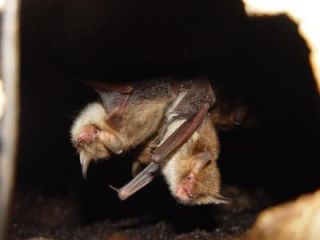
Siemers et al., Current Biology Volume 22 Issue 14
According to a new study, sex can be deadly – at least for flies looking to get frisky in bat territory. The research, published in the July 24 issue of Current Biology, shows hungry bats eavesdrop on the sounds of fly sex to home in on the unsuspecting insects.
Scientists have long suggested that mating can make animals more vulnerable to predators, but this is the first experiment to demonstrate the mechanism underlying the elevated risk. A team from the Max Planck Institute for Ornithology in Germany, led by the late Björn Siemers, studied the interactions between bats and flies sharing a cowshed. They determined the sounds made by fly couples made them conspicuous to hunting bats and increased their chances of becoming dinner.
The researchers set up cameras in a cowshed that was home to a colony of Natterer's bats (Myotis nattereri) and numerous house flies (Musca domestica). They already knew flies make up a big part of the diet of these bats. What they were not sure of was how the bats found the flies.
Like many other bats, Natterer's bats use echolocation to navigate and find prey. The bats emit high frequency sounds and listen for the echoes that return from objects in the environment, creating a picture of the scene in front of them with sound. Siemers and his colleagues found the bats, using echolocation, could easily find and catch flies in flight, but they seemed unable to detect stationary flies. At night, when the bats were active, the flies sat or walked on the ceiling. If a bat tried to echolocate a stationary fly, the powerful echoes bouncing back from the ceiling overpowered the weaker echoes from the flies, rendering them invisible to the bats.
The video above (via Siemers et al., Current Biology Volume 22 Issue 14) shows a Natterer's bat catching a pair of copulating flies (black circle) from the cowshed ceiling and a Natterer's bat attacking an ultrasonic loudspeaker that plays fly copulation buzzes in the cowshed.
That's where the fly sex becomes important. In a pre-mating courtship ritual, the male fly makes a burst of clicking sounds with his wings. These clicks alerted the bats to the pair's location. Once locked onto the sound, the bats would swoop in and grab both flies, using their tail membrane like a catcher's glove. Bats attacked 26 percent of mating flies, successfully capturing and eating both flies about 60 percent of the time.
Members of Siemers' team were voyeurs in the cowshed for four years, observing more than 1,100 acts of fly sex. To confirm the bats were using clicks to locate mating flies, the researchers played recordings of fly sounds through speakers. The bats attacked the speakers whenever they played fly clicks associated with mating, but ignored them when they played white noise or the faint sound of the flies walking. The team also mounted pairs of dead flies, posed in the act of mating, on the ceiling. These noiseless pairs were never attacked by the bats.
This study shows that mating can be risky business. Animals engaged in sex are often more conspicuous and distracted in their attention. Natterer's bats have learned how to take advantage of this to nab a double-meal deal on the fly.


